The C&S Coal Chutes: Pine, Como, Dickey, Pitkin and almost Breckenridge
1234
... 9




















1234
... 9
The C&S Coal Chutes: Pine, Como, Dickey, Pitkin and almost Breckenridge
|
This post was updated on .
I have been drawing track plans, for the past several months, for the after-retirement Sn3 layout I hope to build of the C&S, set in the summer of 1909. Every time I get out my T-square and compass, I’m always drawn back to Platte Canon in general and the town of Pine in specific.
Located about half way between Denver and Como, Pine (AKA Pine Grove) was an important coaling and helper station between the two terminals. The walls of Platte Canon were steep to the east of Pine, but grades generally less than 3%. To the west of Pine, the Canon became wider, in some places an open valley, but the grades were steeper, between 3.3% and 4.0%. From the earliest days on the DSP&P, locomotives were coaled at Pine and one or more helpers were added to west bound freights. The station always had a wye for turning helpers, with the depot on the main within the legs of the wye. In the early years, long coaling platforms to the south of the main allowed for coaling of locomotives by hand. In the 20th century there was one of the signature C&S coaling trestles with chutes, to allow mechanical gravity coaling of motive power, just to the south of the mainline opposite the depot. There was a passing / house track to the north of the mainline, in front of the depot, and a long storage track to the south of the coaling trestle for storage of cars of company coal. This view of Pine from a hill to the northwest, taken in the late 1920s, gives a good overview of the station:  Sanborn Postcard, Colorado Railroad Museum Collection, in Digerness, The Mineral Belt I, page 172.  Joe Crea track diagram, from “Slim Gauge News” All-in-all, an attractive C&S station for modeling purposes. Curiously, there was never a water tank at Pine to allow watering all those helpers, the nearest tank being at Crossons five miles to the west. Obviously the centerpiece for any Sn3 model would be the coaling trestle: http://digital.denverlibrary.org/cdm/singleitem/collection/p15330coll22/id/12030/rec/704 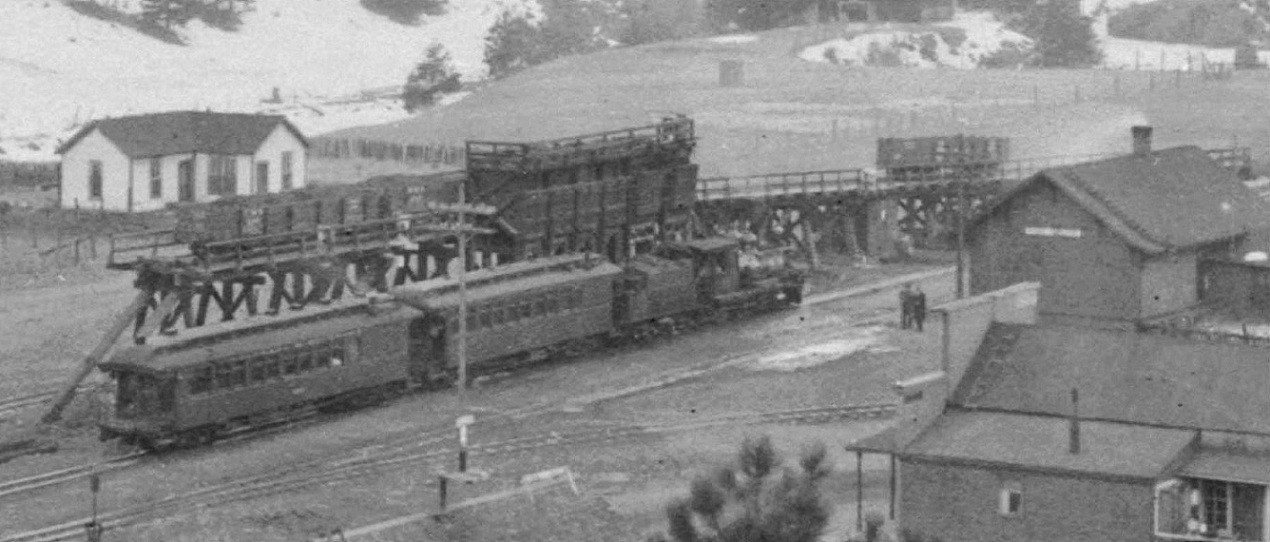 Denver Water Board special, 1929. Fortunately, Joe Crea published drawings of the C&S coaling trestles at Pine, Pitkin and Dickey back in the late 1970s in an issue of Bob Brown's Slim Gauge News, the predecessor to the Gazette. The notes state that Joe redrew the plans from dimensions and sketches by Elwood Bell. Since the drawings referenced the 6-bin structures at Pine and Pitkin and the 12-bin structure at Dickey (6-bin chutes on either side of the trestle, serving two tracks), I jumped to the conclusion thirty-some-odd years ago that all the structures were built at the same time, in 1901-1902, to the same general plans, as a property improvement by the new C&S management. The Pine coal chute differed from both Pitkin and Dickey in that it had four chutes that were similar in size to the latter’s chutes, but the two chutes on the west end of the bin structure were larger. Joe detailed these two west end chutes in a side bar on his drawings. I again jumped to the conclusion that the chutes at Pine were built with six identical bins c1901-1902, and that the two westward chutes were enlarged, sometime in the 1920s, likely to accommodate the large coal capacity of the newly arrived B-4-F class 2-8-0s from the DB&W. These two photographs illustrate the difference in size of the bins / chutes at Pine: http://digital.denverlibrary.org/cdm/singleitem/collection/p15330coll22/id/42241/rec/11 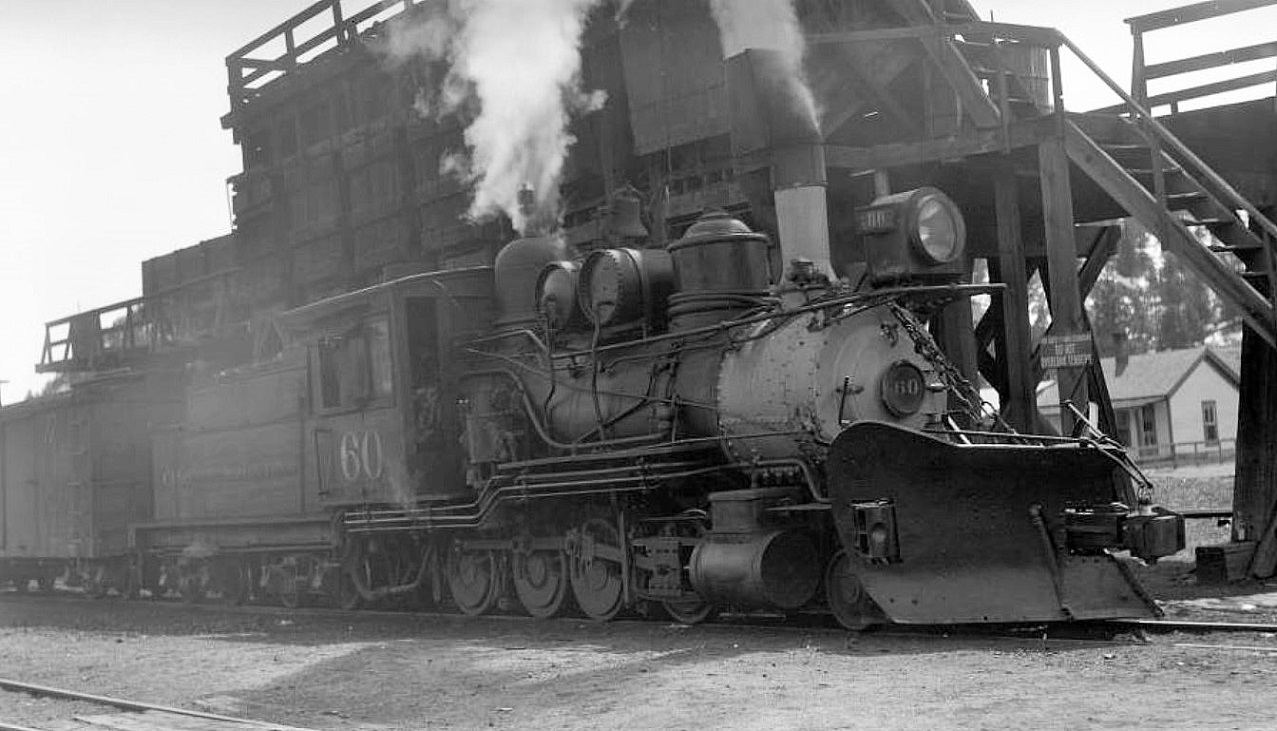 Otto Perry photo of C&S 60 at the chutes with the last passenger train to Leadville, April 9, 1937.  Late 1920s-early 1930s. Jefferson County Historic Society, #169. In the Klingers’ Platte Canon Memories . . . , page 119. This explanation of the chute arrangement at Pine made sense to me, a logical explanation of an oddity. Unfortunately, as we shall see, the explanation was pure fantasy, the truth far more complicated. A couple of months ago, I enlarged this DPL photo by McClure, from the mid to late 1890s to study the structures behind the railroad tracks at Pine. I noticed something in the enlargement that had not been apparent in the small reproductions of this photo in my books: http://cdm16079.contentdm.oclc.org/cdm/singleitem/collection/p15330coll21/id/3681/rec/5  At the right frame it is obvious that the track on which the two coaches are spotted begins to climb up the west end of the coaling trestle grade. So, the Pine coal trestle and chutes had to be in place by the mid to late 1890s, during DL&G days. So, just when was the coal trestle at Pine built and who built it?? Curious, I took out my copy of the Old Testament to see what Mac Poor had to say on the subject. Chapter XXII of Denver South Park & Pacific is a mile-by-mile station list of the entire road. The entry for Pine Grove on page 419 mentions the depot dimensions and the fact that there was a “coal chute, 3 shovelers and an engine hostler”, but doesn’t address when the coal chute was built. So, I turned to the facilities list at Como, to see when the 8 bin covered structure there was built, perhaps a contemporary of that at Pine. But to my dismay, Mac Poor lists every conceivable railroad structure at the division point, except the coal chutes!! Turning to Poor’s descriptions of Pitkin and Dickey, some of my early assumptions were validated: Pitkin: “In 1901, the railroad built a coal chute at the cost of $2,717.38.” Dickey: “The Colorado & Southern built a coal chute here in 1902 at the cost of $4,397.82." (Evidently 12 bins didn’t cost twice as much as 6 bins.) But I still didn’t have any idea when the Pine coal trestle was built. Then I recalled that another coal chute, never photographed to my knowledge, existed at Schwanders. Mac Poor’s entry for that station was astounding: “At various times the railroad facilities consisted of a 47,500 gallon wood water tank, an eight-pocket coal chute, a wye and 2,634 feet of side track. . . Old Union Pacific records tell that the coal chute at Schwanders was built in 1884 at the cost of $2,796.36. It was removed in May, 1894.” Built in 1884!! That means any number of Congdon stacked Mason, Baldwin, Brooks and Cooke locomotives took coal there! And eight chutes? Were there eight chutes in a row serving one track or a double four-pocket set of bins like the double six-pocket chutes later built at Dickey? If eight-bins in a row, was the entire structure covered like the structure at Como? Was the coaling trestle at Como a contemporary, also built in 1884? I found no further answers in Poor’s book, so went back to the book shelf and took out the New Testament to see what the apostles Chappell, Richardson and Hauck had to say. CRA 12, The South Park Line, A Concise History, has no station list like that of the prophet Poor. So I just began to reread the book. And there, in Chapter 4, “Colorado & Southern: An Operations Baedecker”, I found this entry by Bob Richardson: “The DL&G reported, in its inventory for the year 1892, . . . a four-pocket coal chute at Pine Grove.” Four-pockets?? And in place as early as 1892?? Wait, eight pockets at Schwanders, four pockets at Pine Grove—could the Pine Grove structure also date to 1884?? (I mean 4 does go into 8 evenly! That must be some kind of proof, right?). The only 1880s photo of Pine that I’ve ever seen is this one:  Richard Ronzio Collection, in Digerness, Mineral Belt II, page 50. The view is pretty much from the same hill side as the late 1920s view in the first photo above. In the bottom right corner two helper engines are spotted on the west leg of the wye, behind the depot. An enlargement of my best scan from the book is below: 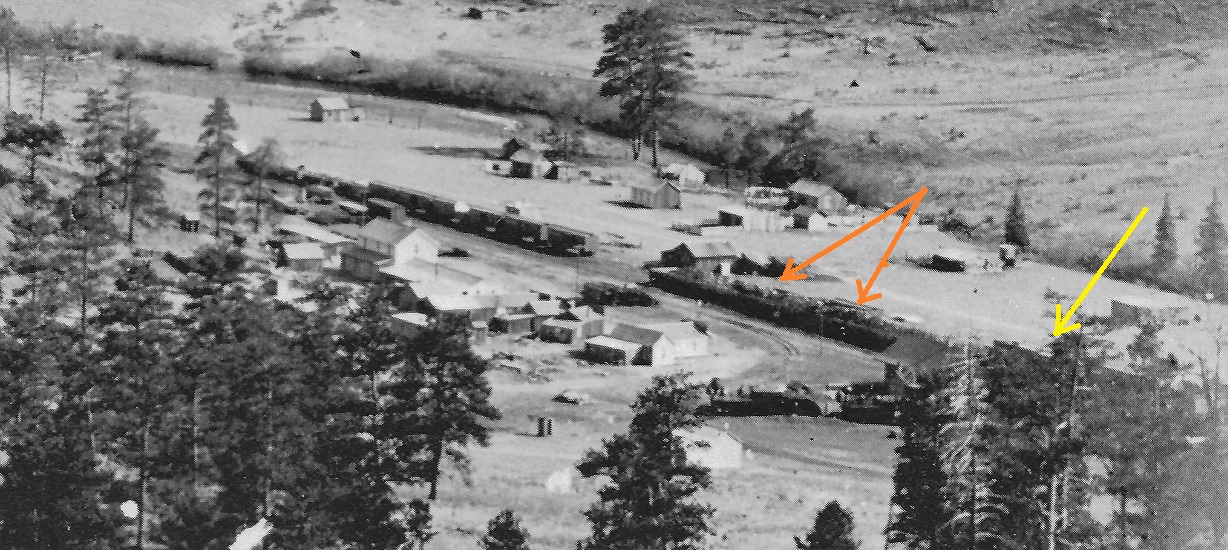 The engine to the left clearly has a Congdon stack, the one behind it appears to have a UP diamond stack. I can’t make out any large 1885 numbers on the tenders, but they are in shadow. My best guess is that the photo dates from 1885-1886. The long coal bins (orange arrows) are visible south of the main to the east of the depot. Some kind of structure appears, obscured by trees, opposite and to the west of the depot, where the coal chutes would later stand (yellow arrow). I cannot tell if the coaling chute is present in the photo or not. Could be. So, if the coal chutes at Pine were there as early as 1892 (possibly as early as 1884) and were built with four pockets per the Union Pacific records, it means that the two additional large chutes were not modifications of the chutes, but additions to the chutes. But when were they added? Were they added in 1901-1902 when the six-pocket chutes were built at Pitkin and Dickey? Or later, in the early to mid-1920s to accommodate the DB&W engines, as I had earlier surmised? More to the point, if I build a 1909 model, how many chutes do I build? The Klingers’ book does have some first decade photos of Pine. This photo of Pine from the South is dated "early 1900s”, perhaps as close as I will get: 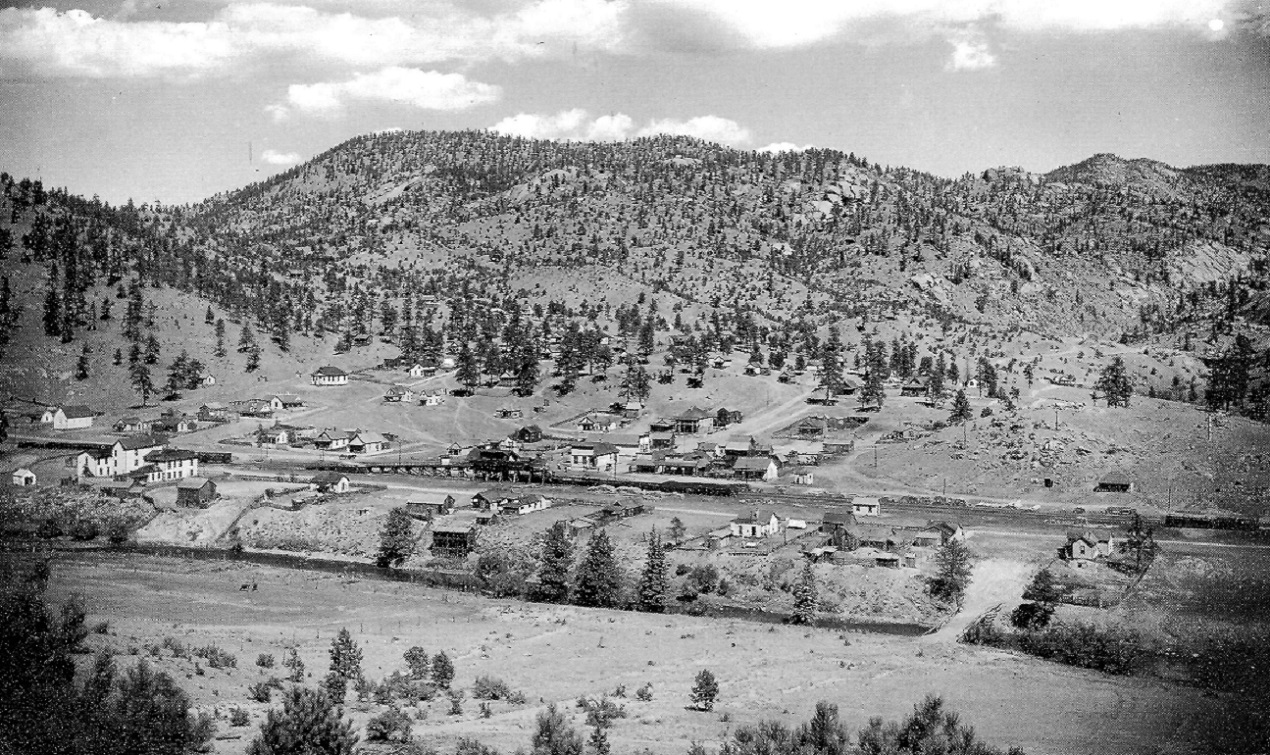 John Halliman Collection, in the Klingers’ Platte Canon Memories . . . , page 115. The coaling trestle is different from the 1920s-1930s photos at the beginning of the post. The trestle beyond the coal bins is shorter than the later trestle, only three stringer spans between bents not four. And the two heavy diagonal end braces haven’t been added. Enlarging the photo:  The coal bins are the odd black rectangle that partially obscures the depot roof. The length of the black rectangle as just about the length of two of the trestle stringer spans or about 32 feet per Joe Crea’s plans. That would correspond to, well, four bins per his drawings. So in 1909, it is likely the bins had not yet been rebuilt, and were still four in number. And then there is this DPL photo accredited to McClure, and probably around 1908-1910: http://digital.denverlibrary.org/cdm/singleitem/collection/p15330coll22/id/77809/rec/13 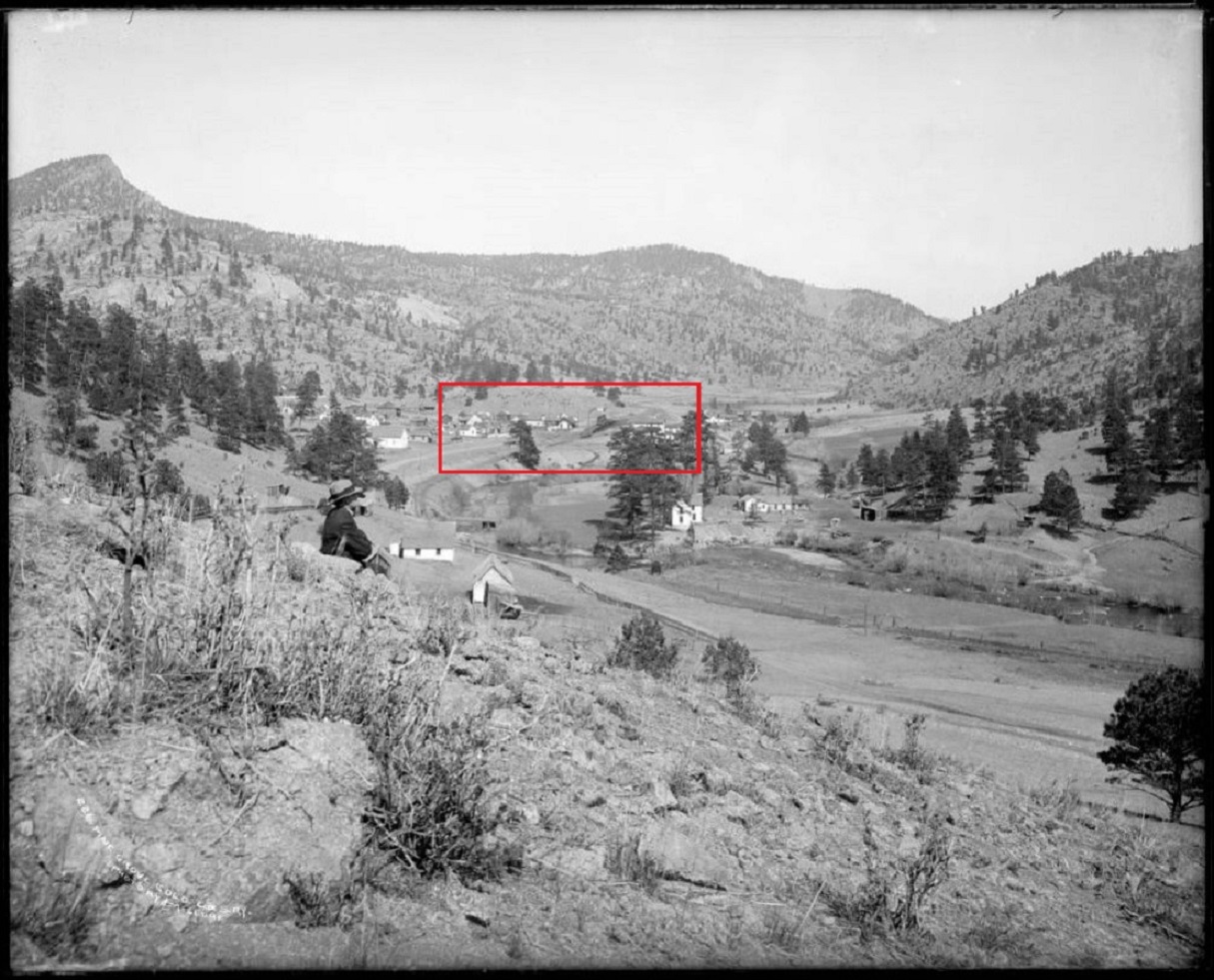 If you enlarge the outlined portion of the photo, the odd black rectangle over the coal bins in the previous photo is explained—it’s a shadow:  The Pine coal chutes had a covered bin storage area, not like at Como where both the bins and the unloading section of trestle were covered, but just the bins. It reminds me of the covered bins at the coaling station at Vance Junction on the Rio Grande Southern. The long coaling platform, full of storage coal, still exists to the east of the coaling trestle. The depot appears freshly painted in the light and dark trim scheme. So the next question that comes up is when was the roof of the coaling bins removed and the extra chutes added? Early 1920s or earlier? This photo seems later, perhaps 1915-1920, as some structures are missing, or have additions and are generally in less repair: 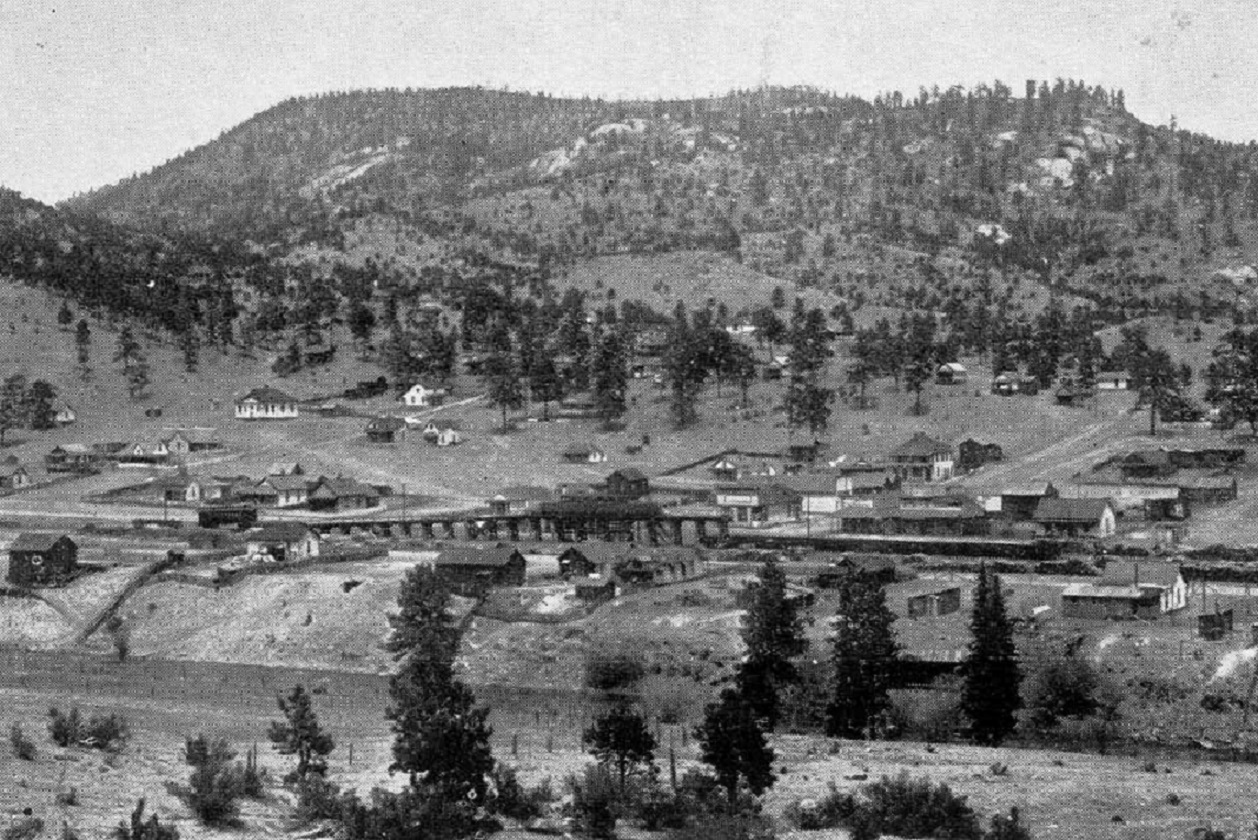 The trestle has two coal cars in front of the bins, but the dark rectangular shadow from the roof of the structure seems to be gone. And it almost looks like the later retaining rails are in place. This 1920s photo of the Pine depot does show the shadow of the retaining rails from the coal bins, implying the roof of the structure is gone: 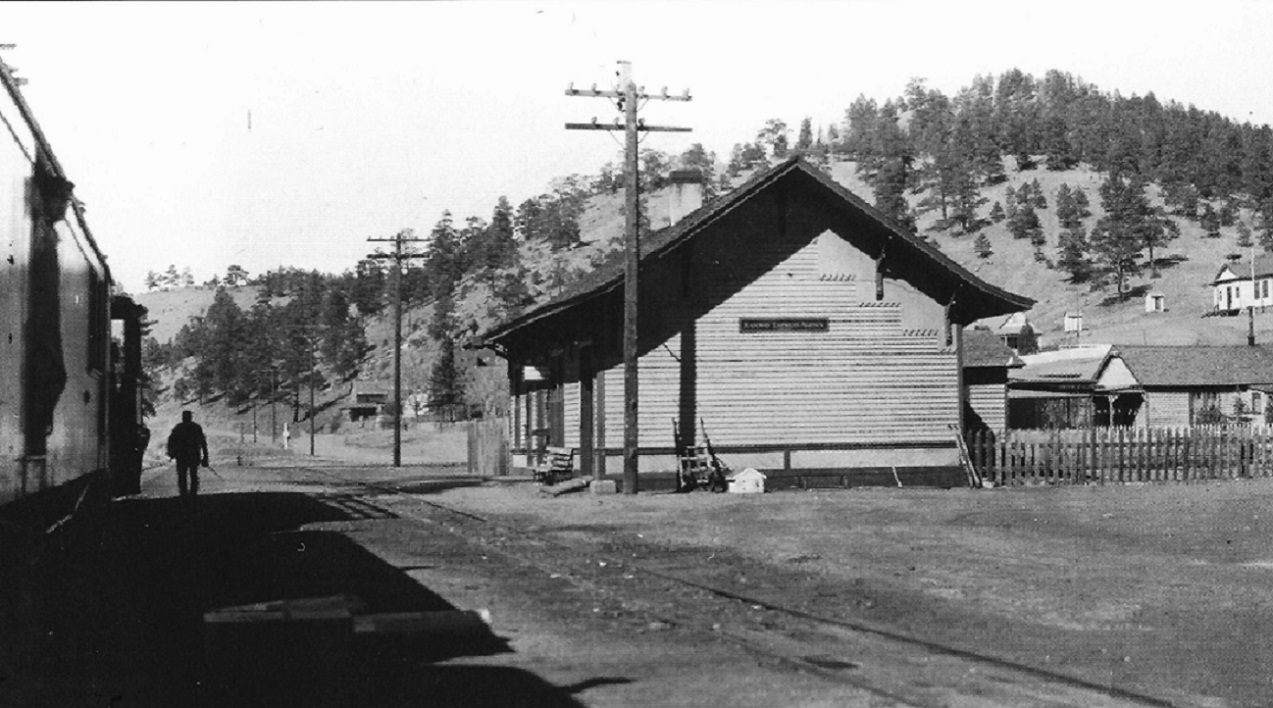 Colorado Railroad Museum Collection, in the Klingers’ Platte Canon Memories . . . , page 119. By the way, has anyone noticed that the Pine depot is a near twin of the Fairplay depot? I couldn’t find any more photos that shed light on the coaling chutes details, but there is one more interesting photo to include. When the C&S ran day picnic excursions to Dome Rock and Crystal Lake, after unloading the picnickers, the engines would move the empty passenger cars on west to Pine. There the engine would be turned and coaled and the passenger/excursion cars set out until late afternoon, when the train would head back east to return the tourists to their Denver hotels. That likely explains the passenger cars that show up in early photos of Pine. I think Chris may have already posted this enlargement, but it is evident that the coal trestle at Pine wasn’t just for coal cars: http://digital.denverlibrary.org/cdm/singleitem/collection/p15330coll22/id/12029/rec/5 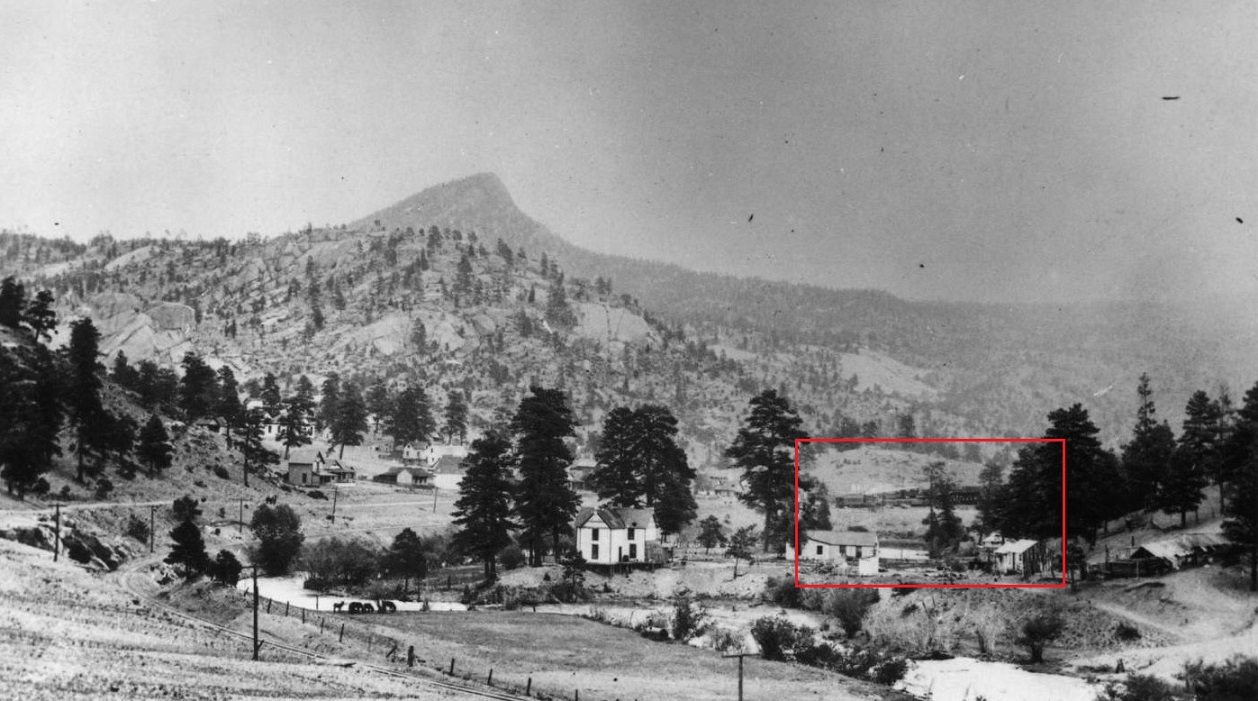 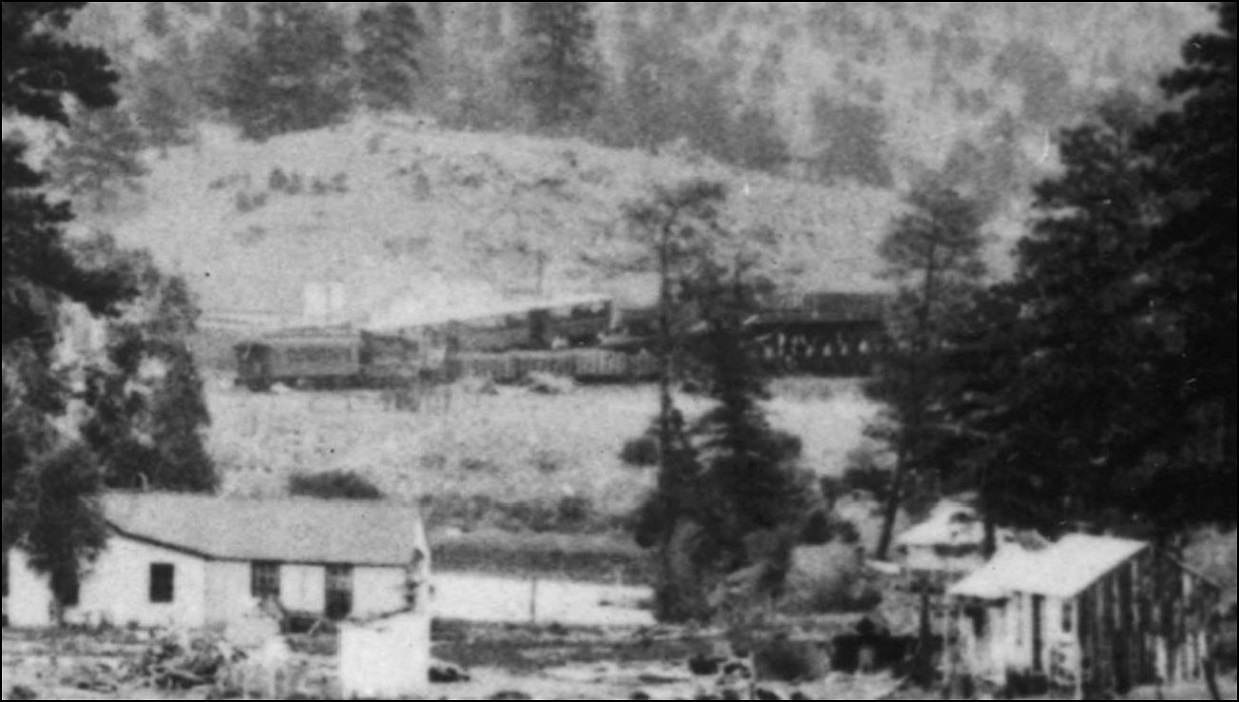 So, questions for The Forum: 1. Does anyone know of written records of when the coal chutes at Pine were built? And the chutes at Como for that matter? 2. Are there any photos of the Pine chutes clearly showing only four chutes? 3. Any photos of the fabled coaling chutes at Schwanders? 4. Does anyone know definitively when the extra two large chutes were added to the Pine coaling structure? 5. Are my conclusions valid, or am I being delusional and making stuff up? Jim in the Wet Pacific Northwest
Jim Courtney
Poulsbo, WA |
Re: The Coal Chutes at Pine, MP 42.39: Four bins? Six Bins? Give me a Hollar!
|
Oh My! What a wonderful article, Jim.
A subject very close to my heart since my first really decent contest model built in '85 was a generic version based on Como with the very little information I had at the time here in New Zealand. I had only the Mineral Belt II at the time that showed any photo's and had already built a Mine-style orebin which I used as a stand in. Afterwards I sent a photo of it to Stan and Sheldon at Coronado Scale Models and they in return sent me the plans, Boo Hoo.
UpSideDownC
in New Zealand |
Re: The Coal Chutes at Pine, MP 42.39: Four bins? Six Bins? Give me a Hollar!
|
This post was updated on .
Thanks for the compliment, Chris.
I've posted everything I've found on the Pine coal chutes, hoping others can fill in some of the blanks. That would include any information or photos of the other coal chutes as well. When were the Como chutes built, anyone know? This "Not Ready-to-Run History" is hard sometimes. 
Jim Courtney
Poulsbo, WA |
Re: The Coal Chutes at Pine, MP 42.39: Four bins? Six Bins? Give me a Hollar!
|
Burnett&Clifton Coalchute Patent: http://www.google.com/patents/US270736
Some model drawings(not C&S) for details: http://www.trainlife.com/articles/394/coaling-trestle The RGS version at Rico was more C&S sized, but included a platform opposite for more storage. What a chore shovelling out of coalcars and then back across into the Bins later....I pity those poor Sectionmen. http://digital.denverlibrary.org/cdm/fullbrowser/collection/p15330coll22/id/75640/rv/singleitem Jim, your arrows in the early Pine photo appear to be pointing to Boxcars on the adjacent track to me. It would be safe to assume the coaling platform was originally along the lines of the type at Hancock(and others). As for the Passenger cars parked up the Trestle approach; well that's a Switchmans trick for gravity-assisted runarounds, it just saves going all the way out to end of the passing siding to get around the train. Apparently the Chute Roof structure was optional, it may have burned in the case of the Pine Grove Chutes. Note that in C&S Platte Canon Memories & some, there is a mislabled picture of the Chutes at Dickey included with the Pine Grove information.(pg117top).  from the Park County Archives http://www.parkcoarchives.org/photo_inventory/inventory_0495to0595/552.jpg And enlarged from the above photo already posted, check out the wear on the Stairtreads from countless boots trudging up and down.  http://digital.denverlibrary.org/cdm/singleitem/collection/p15330coll22/id/42241/rec/11
UpSideDownC
in New Zealand |
Re: The C&S Coal Chutes: Four bins? Six Bins? Eight Bins? Twelve Bins?
|
This post was updated on .
Thanks for the links, Chris.
As for: Jim, your arrows in the early Pine photo appear to be pointing to Boxcars on the adjacent track to me. It would be safe to assume the coaling platform was originally along the lines of the type at Hancock(and others). Well, I agree with you. If the yellow arrow "structure" was a coal bin, it seems too far west and not opposite the depot. The coaling structure in all the other photos is opposite and just a smidgin to the east of the depot. Truth is, until I read Mac Poor's statement that the Schwanders coal chutes were built in 1884, I would never have looked for a coaling chute in an 1880s photo of Pine--I've always thought of the C&S coaling trestles as TOTC buildings. Evidently, that's not true. I've changed the title of this thread to that of a generic C&S coaling trestle discussion. So let's post as many photos of these neat creatures here as we can, both prototype and model. That will give Mike Trent an excuse to post more photos of his beautiful O scale Dickey trestle and chutes. And it looks to me that Don Pacetti has built a very nice HOn3 model of the Como coaling bins. Perhaps he could offer us some close-ups? And Chris, do you have photos of your 1985 model of the Como coal bins?? If so, post them here as well, I'd love to see them. I'll start: http://digital.denverlibrary.org/cdm/singleitem/collection/p15330coll22/id/43672 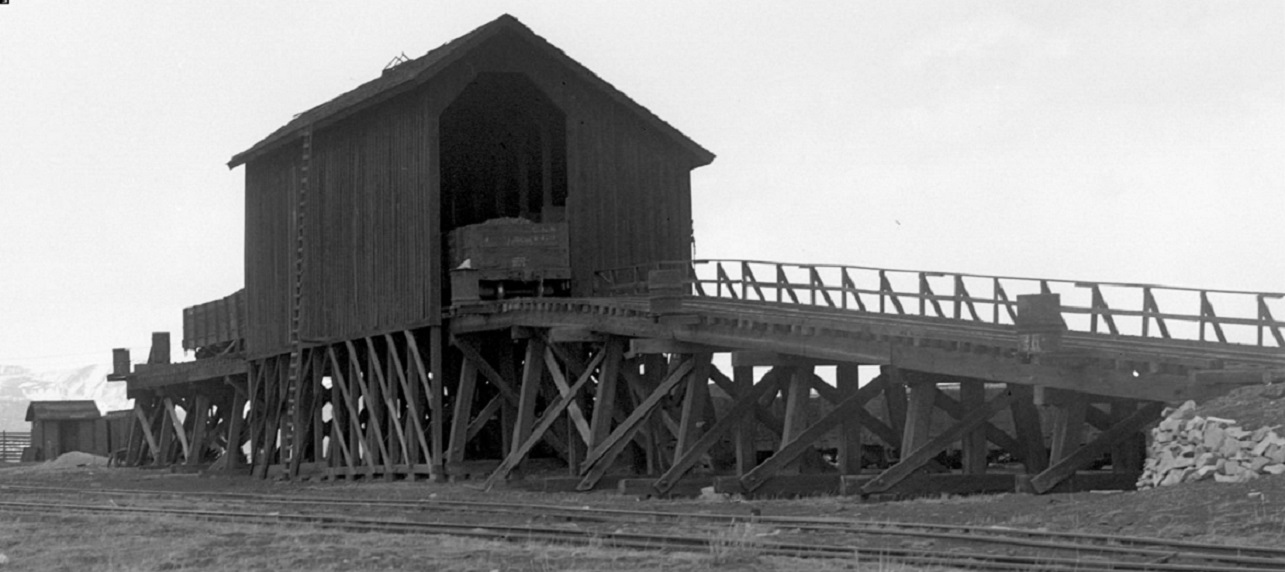 Como coal bins, April 11, 1937. Otto Perry http://digital.denverlibrary.org/cdm/singleitem/collection/p15330coll22/id/5109/rec/25  Como coal bins from the east, c1929
Jim Courtney
Poulsbo, WA |
Re: The C&S Coal Chutes: Four bins? Six Bins? Eight Bins? Twelve Bins?
|
Both the Pine Grove, Denver and Como chutes had components of the standard UP coal chute but were different. Great article from The Railroad & Engineering Journal, Aug, 1889.
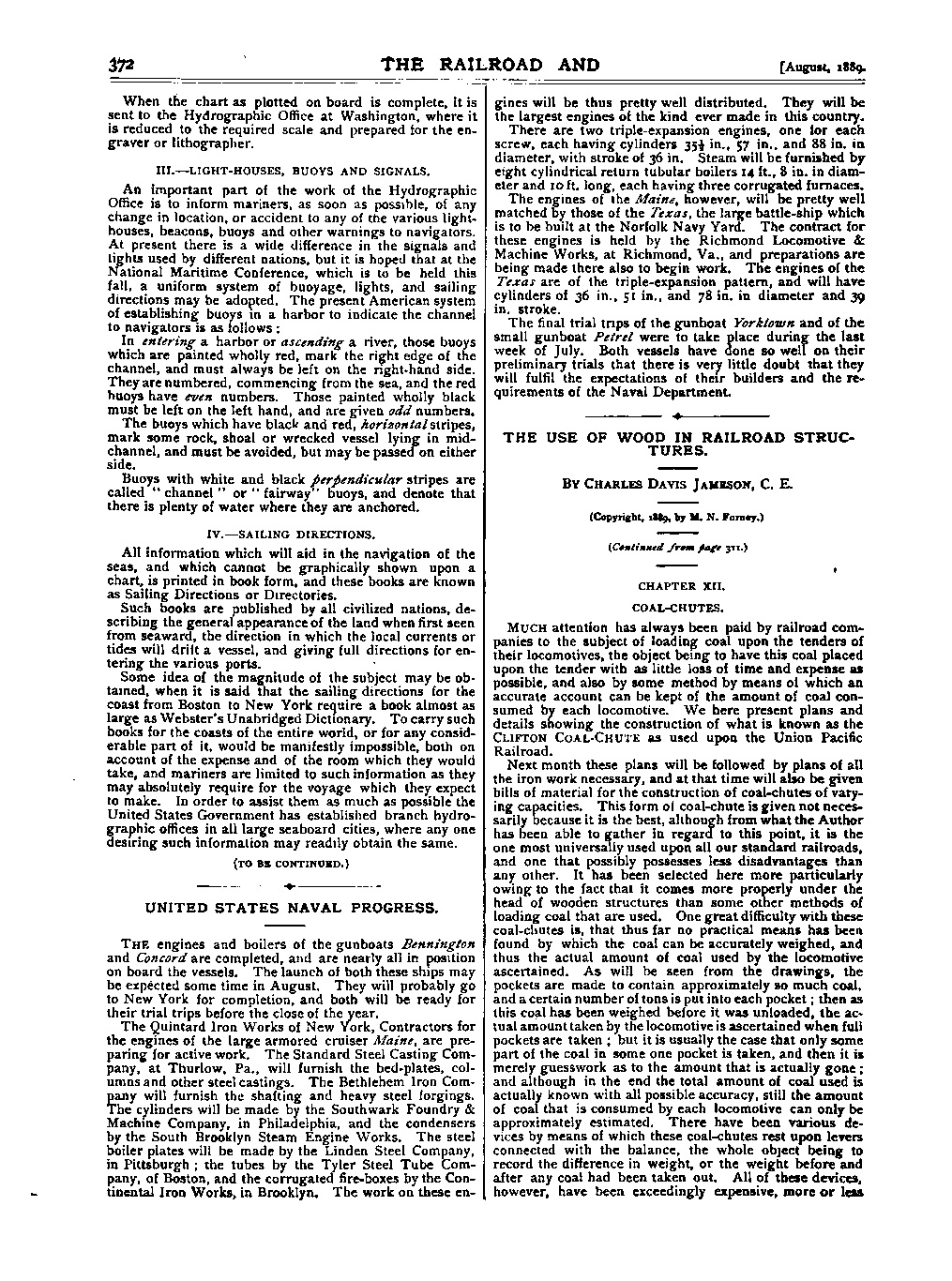   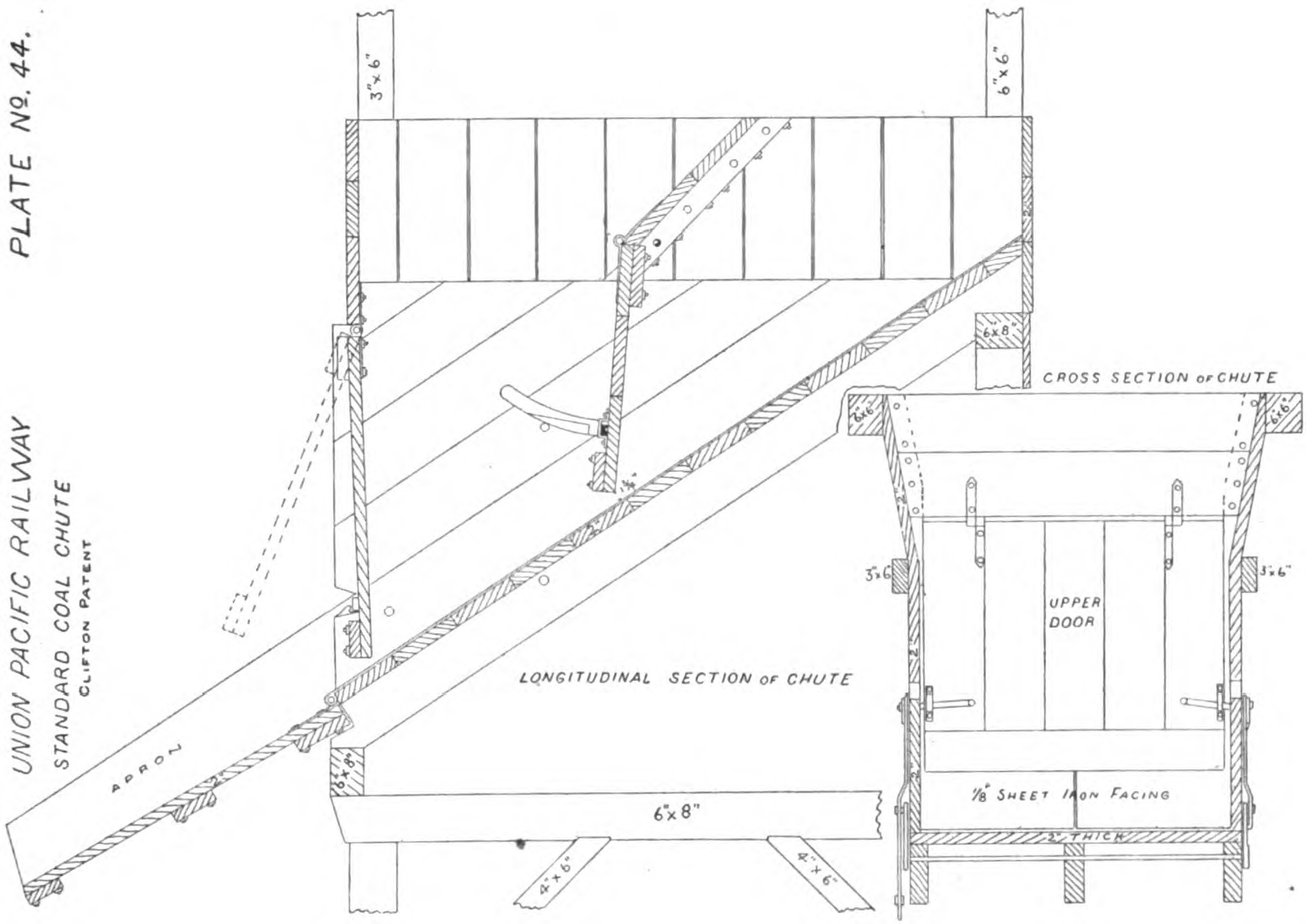  
|
Re: The C&S Coal Chutes: Four bins? Six Bins? Eight Bins? Twelve Bins?
|
Great information and drawings, Jeff.
Do you think that the publication date of 1889 suggests that the Pine Grove and Como coal bins / chutes were built as early as 1884?? Would you consider allowing Darel to post the article and drawings in the "Files" section for better resolution and viewing? Thanks again, Jim
Jim Courtney
Poulsbo, WA |
Re: The C&S Coal Chutes: Four bins? Six Bins? Eight Bins? Twelve Bins?
|
In reply to this post by Jim Courtney
The coal chutes at Dicky had six pocket bins on either side of the trestle.
Number 76 takes coal at the Dickey coaling chutes in the early 1930s:  Colorado Railroad Museum Collection, in the Klingers' Platte Canon Memories . . . , page 117.
Jim Courtney
Poulsbo, WA |
Re: The C&S Coal Chutes: Four bins? Six Bins? Eight Bins? Twelve Bins?
|
In reply to this post by Jeff Ramsey
The "large armored cruiser"Maine?
|
Re: The C&S Coal Chutes: Four bins? Six Bins? Eight Bins? Twelve Bins?
|
Remember the 1884 "chute" at Schwanders was removed in 1894.When was it replaced? It would seem that the chute would be its replacement.
|
Re: The C&S Coal Chutes: Four bins? Six Bins? Eight Bins? Twelve Bins?
|
Further questions-or answers can be checked out by looking at the Bridge and Building suppliment in the Trout Creek valuation map section in the Blog files .Also take a look at Cliff Mestel's chart of DSP&P structures on Steve Hatch's Railway Engineering website.
|
Re: The C&S Coal Chutes: Four bins? Six Bins? Eight Bins? Twelve Bins?
|
This post was updated on .
OK, Robert, I think your really on to something here, regarding the Schwanders chute(s). There were likely more than one.
The June, 1886 UP Ry. Colorado Division B&B Book with annotations says: Coal Tower and Chute (singular)--Small Chute from Denver Yd. Remarks: From Denver, '89 Rmv'd." The Receiver's Inventory of October, 1893 lists at Schwanders: "Coal chute, 1 pocket." (Even though the previous document said it was removed in 1889??) The DL&G B&B Book, dated November 1, 1894 and annotated and updated by it's owner (perhaps by its subsequent owner, ie the C&S??): "Coal chutes, 8 pockets 11/1900" So, maybe Mac Poor co-mingled two different facts: 1. A small coal chute appeared at Schwanders as early as 1884, possibly moved from Denver, and it was removed between 1889 and 1894 (the Receiver's Inventory shows it still there in 1893). 2. Then, a second coaling structure, a big 8-pocket chute, was built by the successor owner (C&S) in November, 1900, which "annotated and updated" the B&B book of 1894. The construction date for the later 8-pocket structure puts us back to the first years of C&S management and would make the 8-pocket chute at Schwanders (1900) a contemporary to that at Pitkin (1901) and Dickey (1902). Mac Poor's cited construction cost of the 8-pocket chute at Schwanders, $2,796.36, was within a $100.00 of the later cited cost of constructing the Pitkin chutes. Wonder if the Schwanders trestle and chutes looked like the other two? Is this making any sense? And Cliff Mestel's DSP&P B&B Inventory at http://www.railwayeng.com/dspp/rowbuild.htm lists the Pine 4-pocket coal chutes as being in place as early as 1890; the Como "10-pocket" coal chute is not listed in 1890, but shows up in 1891. So is 1891 a good build date for the Como structure? And BTW did the Como structure have 8 or 10 pockets? Thanks for the links, Robert. I was hoping that my post would unearth more information!
Jim Courtney
Poulsbo, WA |
Re: The C&S Coal Chutes: Four bins? Six Bins? Eight Bins? Twelve Bins?
|
This picture of the Como roundhouse gives a nice end elevation of the coal chute:
 The lead tracks into the roundhouse appear to be salvaged, so presumably this is post-abandonment? (Did they really abandon a coal car on the trestle?) |
Re: The C&S Coal Chutes: Four bins? Six Bins? Eight Bins? Twelve Bins?
|
Here are the 1918 ICC Valuation Summary Notes for Como Coal Pockets

|
Re: The C&S Coal Chutes: Four bins? Six Bins? Eight Bins? Twelve Bins?
|
In reply to this post by Jim Courtney
Also there was some material recently in Bogies and Loop about a coal chute that was being built at Breckinridge-but never completed.There is a Denver map dated 1882-panoramic showing buildings and bridges-that shows two coal chute like structures in an area near the South Park yards that is so near to D&RG trackage that its unclear which railroad owns them.If they belong to the DSP&P,could one of them be the one that was moved?DPL reference CG4514 .D4 1882 F55
|
Re: The C&S Coal Chutes: Four bins? Six Bins? Eight Bins? Twelve Bins?
|
In reply to this post by Don Pacetti
Thanks for the additional drawings, Don.
Can you clarify with a reference whether the Como coal bins had 8 pockets or 10 pockets? I've only seen clear photographs of the butt side of the structure. Your HOn3 model was built with 8 pockets, I see. Any chance of posting a close up to the pocket-side elevation--or are you saving that for a blog post?? Thanks again for participating here! Every day I learn a little more about our favorite narrow gauge road.
Jim Courtney
Poulsbo, WA |
Re: The C&S Coal Chutes: Four bins? Six Bins? Eight Bins? Twelve Bins?
|
In reply to this post by Jeff Young
Jeff, here is another "end of track" bumping post, this time at the end of a coaling trestle:
http://digital.denverlibrary.org/cdm/fullbrowser/collection/p15330coll22/id/43672/rv/singleitem 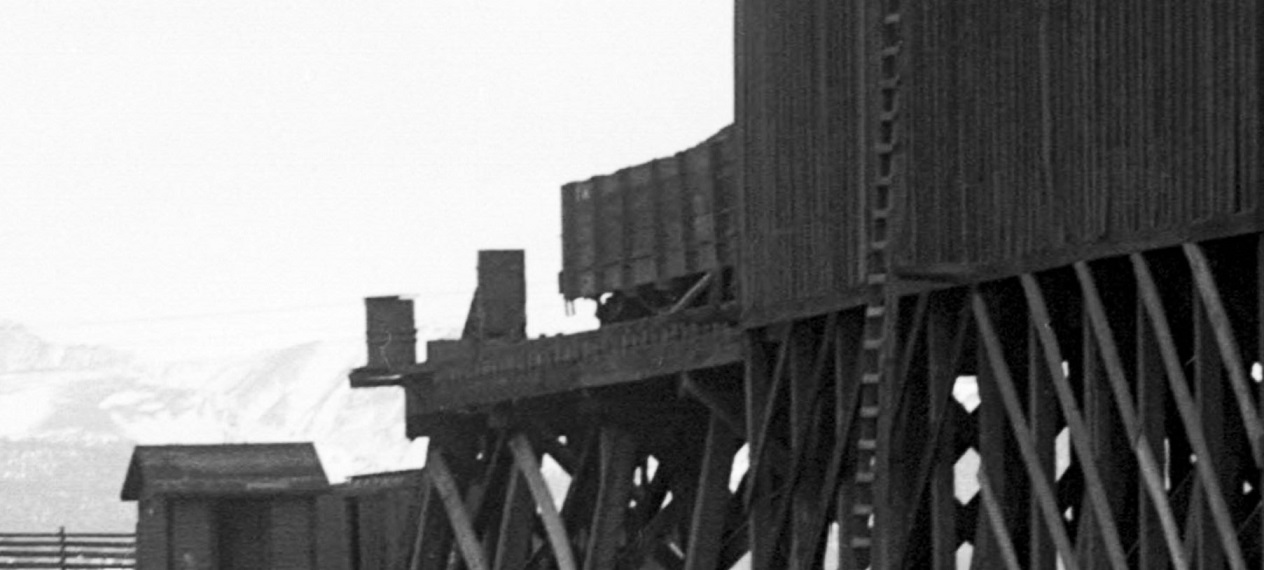 Looks like the two end timbers, very close together, on your Como "end elevation" photo supported the bumping post, not the end of the trestle, as at Pine: http://digital.denverlibrary.org/cdm/singleitem/collection/p15330coll22/id/12030/rec/704 
Jim Courtney
Poulsbo, WA |
Re: The C&S Coal Chutes: Four bins? Six Bins? Eight Bins? Twelve Bins?
|
In reply to this post by Jim Courtney
It is in tons not the number of pockets, but here is some info from a 1905 C&S "List of Officers, Agents and Stations"
Amount in tons Location Chute Platform total Pine Grove 24 500 524 Como 50 900 950 Dickey 96 2000 2096 Leadville 1500 1500 Schwanders 64 500 564 Pitkin 64 64 KenMartin |
Re: The C&S Coal Chutes: Four bins? Six Bins? Eight Bins? Twelve Bins?
|
In reply to this post by Jim Courtney
CONTENTS DELETED
The author has deleted this message.
|
Re: The C&S Coal Chutes: Four bins? Six Bins? Eight Bins? Twelve Bins?
|
Ken and John, thanks for the additional information.
Ken, given that we know that different locations had different numbers of bins and the likely number of bins, it seems that bin capacity (tons) varied--not all bins were created equal. John, do you have similar data for the other locations: Como, Schwanders, Pitkin and Dickey?? Thanks again for the new (to me) information. Perhaps, before this thread is over, we can create a comprehensive compendium of information about all things related to the C&S coal chutes.
Jim Courtney
Poulsbo, WA |
«
Return to C&Sng Discussion Forum
|
1 view|%1 views
| Free forum by Nabble | Edit this page |

